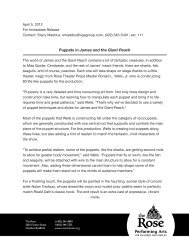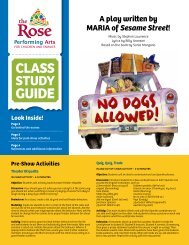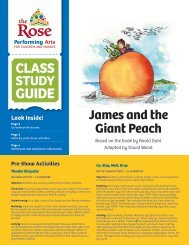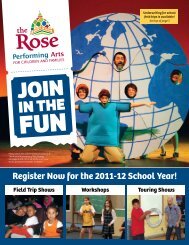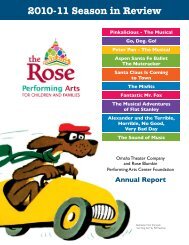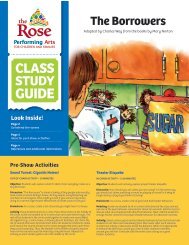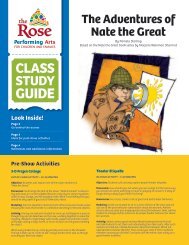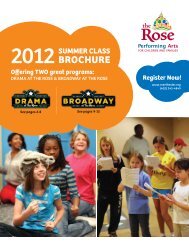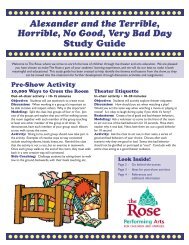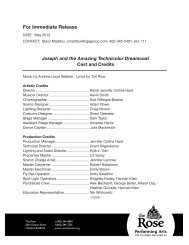Diary of a Worm, a Spider, and a Fly - The Music Hall
Diary of a Worm, a Spider, and a Fly - The Music Hall
Diary of a Worm, a Spider, and a Fly - The Music Hall
You also want an ePaper? Increase the reach of your titles
YUMPU automatically turns print PDFs into web optimized ePapers that Google loves.
Post-Show Activities<br />
A Point-<strong>of</strong>-View Activity: What Do You See?<br />
IN- AND OUT-OF-CHAIR ACTIVITY • 5-10 MINUTES<br />
Objective: Students will use their imaginations to see the world from the<br />
point-<strong>of</strong>-view <strong>of</strong> an insect.<br />
Discussion: Sitting in your chair, look around the room. What do you see?<br />
Now lie on the ground like a worm <strong>and</strong> look around the room. What do<br />
you see now? How does a worm see the world differently than people<br />
do? Now st<strong>and</strong> up <strong>and</strong> bend over so you can see behind yourself through<br />
your legs like a spider hanging from a web. What do you see? How is this<br />
different from a worm or a person? How does a fly see the world? Using<br />
your imagination, what would you have to do to see the world like a fly?<br />
What would you see?<br />
In theater we have to underst<strong>and</strong> the way other characters see the world.<br />
Actors have to underst<strong>and</strong> why the characters behave the way they do.<br />
Designers must know what their world looks like <strong>and</strong> change our world to<br />
look like it.<br />
Activity: H<strong>and</strong> each student three pieces <strong>of</strong> drawing paper, one for<br />
each character. On the “worm” paper, students will draw the classroom<br />
from a worm’s point <strong>of</strong> view. On the “spider” paper, they will draw the<br />
classroom from a spider’s point <strong>of</strong> view. On the “fly” paper, they will draw<br />
the classroom from a fly’s point <strong>of</strong> view. If you are comfortable, allow<br />
students to lie down like worm or hang upside down like spider while<br />
drawing. <strong>Fly</strong> will, <strong>of</strong> course, be drawn completely from the<br />
student’s imagination.<br />
Sculptors <strong>and</strong> Puppeteers<br />
OUT-OF-CHAIR ACTIVITY • 10-15 MINUTES<br />
Objective: Students will be able to further explore their underst<strong>and</strong>ing <strong>of</strong><br />
the anatomy <strong>of</strong> spiders, worms, <strong>and</strong> flies.<br />
Discussion: How did the actors become different characters from <strong>Diary</strong> <strong>of</strong><br />
a <strong>Worm</strong>, a <strong>Spider</strong>, <strong>and</strong> a <strong>Fly</strong>? What did they do to change how they looked<br />
<strong>and</strong> how they moved? Who were your favorite characters from the show?<br />
Why? What did he/she do during the show? How could you act like<br />
that character?<br />
Modeling: Ask one student to st<strong>and</strong> in front <strong>of</strong> the class in a neutral<br />
position (e.g. st<strong>and</strong>ing straight, facing forward, h<strong>and</strong>s at his/her side). Ask<br />
the rest <strong>of</strong> the class for ideas about how to change this person’s body <strong>and</strong><br />
face to look like the butterfly. With each suggestion, have the volunteer<br />
take the suggestion <strong>and</strong> change his/her body.<br />
Encourage students to think <strong>of</strong> ideas that build on previous ideas.<br />
After taking a few suggestions, tie “invisible strings” to the volunteer’s<br />
h<strong>and</strong>s, head, <strong>and</strong> feet. Announce that you have now made a puppet.<br />
Now whenever you move a string, the puppet responds by moving the<br />
corresponding body part.<br />
Extension: Ask students to find a partner. In each pair, one partner is<br />
labeled “A” <strong>and</strong> the other is “B.” This is just to allow you to speak to the<br />
entire class <strong>and</strong> streamline directions. Partner A is the puppet first <strong>and</strong><br />
Partner B is the sculptor/puppeteer first. Partner A begins in a neutral<br />
position. Announce to Partner Bs that their job is to create a puppet for the<br />
fly. Give Partner B a few moments to sculpt the puppet first, <strong>and</strong> then ask<br />
them to tie strings to their puppets. Partner B now uses the strings to move<br />
his/her puppet around the room.<br />
Switch roles for the partners: Partner B is now the puppet <strong>and</strong> Partner<br />
A is now the sculptor/puppeteer. This time have Partner A create an<br />
earthworm puppet. Repeat the activity with the many characters from<br />
<strong>Diary</strong> <strong>of</strong> a <strong>Worm</strong>, a <strong>Spider</strong>, <strong>and</strong> a <strong>Fly</strong>.<br />
Go, Stop, Melt, Drop<br />
OUT-OF-CHAIR ACTIVITY • 15-20 MINUTES<br />
Objective: Students will be able to use their bodies, voices, <strong>and</strong><br />
imaginations to create characters from <strong>Diary</strong> <strong>of</strong> a <strong>Worm</strong>, a <strong>Spider</strong>,<br />
<strong>and</strong> a <strong>Fly</strong>.<br />
Modeling: Clearing an open space in your classroom, ask students to each<br />
find their own place in the room. Begin explaining the rules to the students:<br />
when the teacher says “GO” that means you may move around the room<br />
<strong>and</strong> talk or make sounds, when the teacher says “STOP” that means you<br />
freeze right where you are <strong>and</strong> are silent. Allow students a chance to<br />
explore these two rules on your prompts. <strong>The</strong>n introduce the final two<br />
rules: when the teacher says “MELT” that means you slowly melt into the<br />
ground, when the teacher says “DROP” that means you safely <strong>and</strong> silently<br />
lay as flat as you can on the floor.<br />
Activity: After modeling, students should be lying flat on the floor. Give<br />
the students a character to become, e.g. “When I say ‘go,’ move around the<br />
room like you are a spider.” Create different experiences for these characters<br />
to encounter: at school, at home, with your friends. Throughout the<br />
activity, you may use the four directions in any order you see fit.<br />
Hot Seating<br />
OUT-OF-CHAIR ACTIVITY • 10-15 MINUTES<br />
Objective: Students will explore the emotions <strong>of</strong> the characters featured in<br />
the play.<br />
Discussion: When an actor plays a character in a play, he/she must take on<br />
the emotions <strong>of</strong> that character. <strong>The</strong> actor must be able to walk, talk, <strong>and</strong><br />
feel like the character he/she is playing.<br />
Brainstorming: Ask the class to help you list all the characters from the<br />
play. Write the names on the board. Under each character’s name, list<br />
physical <strong>and</strong> emotional attributes that most accurately describe the<br />
character. Were the characters ever different than that list during the show?<br />
Make a secondary list <strong>of</strong> these attributes. Who would like to demonstrate<br />
how certain characters move?<br />
Modeling: Each student should pick one character from the list on the<br />
board. Tell him/her to sit as that character. How would his/her h<strong>and</strong>s <strong>and</strong><br />
feet be positioned? Would his/her back be straight or slouched? Next, ask<br />
the students to make their faces look like their character’s emotions. Do<br />
they look angry, scared, or silly?<br />
Ask one volunteer to walk to the front <strong>of</strong> the room <strong>and</strong> sit down facing the<br />
class. Ask them several open-ended questions that they can respond to<br />
“in character.” What do you like to do for fun? How do you feel about your<br />
friends? What is your favorite part about being a worm/spider/fly?<br />
Activity: Ask two to three students to sit together in front <strong>of</strong> the class as<br />
you ask them questions. Remind the students to use their imaginations <strong>and</strong><br />
answer how they think the character would answer.<br />
Side Coaching: How would your voice sound as this character? How does<br />
your character move his arms <strong>and</strong> legs? How does your character feel<br />
about the interviewer?<br />
Extension: Have the students interview each other in partners.<br />
Side Coaching: How would your voice sound as this character? How does<br />
your character move his arms <strong>and</strong> legs? Would your character refuse to<br />
answer some questions? Do they like or dislike the interviewer?<br />
Extension: Have the students interview each other in partners.<br />
STUDY GUIDE 3



